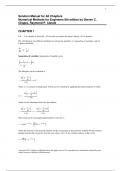Examen
Solution Manual for Numerical Methods for Engineers 8th edition by Steven C. Chapra, Raymond P. Canale.
Solution Manual for Numerical Methods for Engineers 8th edition by Steven C. Chapra, Raymond P. Canale.
[Montrer plus]
Publié le
17 juillet 2023
Nombre de pages
1180
Écrit en
2022/2023
Type
Examen
Contient
Questions et réponses
Titre de l’ouvrage: Numerical Methods for Engineers
Auteur(s): Steven C. Chapra, Raymond P. Canale
Édition: 2006 ISBN: 9780071244299 Édition: Inconnu
Établissement
SM+TB
Cours
SM+TB
Par: prem011014 • 9 mois de cela
Par: abdarefa • 1 année de cela
S'abonner
€17,30
Garantie de satisfaction à 100%
Disponible immédiatement après paiement
En ligne et en PDF
Tu n'es attaché à rien
1 Copyright 202 1 © McGraw -Hill Education. All rights reserved. No reproduction or distribution without the prior written consent of McGraw -Hill Education. Solution Manual for All Chapters Numerical Methods for Engineers 8th edition by Steven C. Chapra, Raymond P. Canale CHAPTER 1 1.1 Use calculus to solve Eq. (1.9) for the case where the initial velocity υ(0) is nonzero. We will illustrate two different methods for solving this problem: (1) separation of variables, and (2) Laplace transform. dv cgvdt m Separation of variables : Separation of variables gives 1dv dtcgvm




